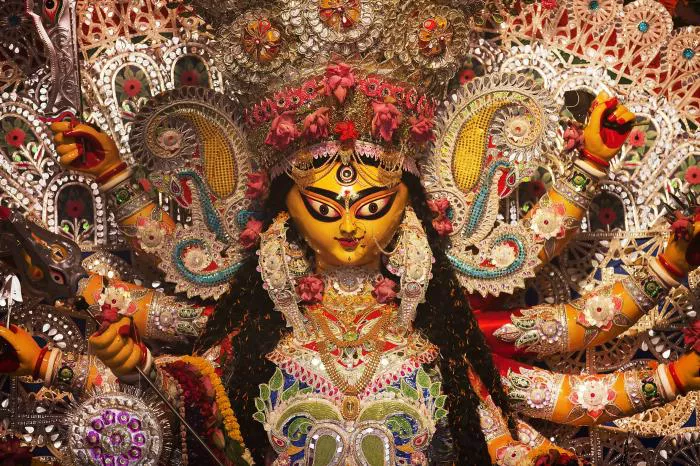As the much-anticipated Durga Puja festival approaches, florists in Jalpaiguri are grappling with a significant crisis—a severe shortage of lotus flowers, a vital component for the ceremonial rituals. This situation has emerged in the wake of devastating floods in South Bengal, which have disrupted the flower supply chain and left traders scrambling to meet the demand for pre-ordered supplies.
Impact of Flooding on Flower Supply
The recent floods in South Bengal have wreaked havoc on the flower market, particularly affecting the supply of essential flowers like lotuses, marigolds, and tuberose sticks. Florists, who traditionally depend on shipments from regions such as Howrah, Bolpur, and South Medinipur, are facing unprecedented challenges this year. The market is currently witnessing a spike in prices due to the sudden scarcity of these flowers. For instance, lotus flowers are now selling for ₹60 each, a steep increase compared to previous prices.
Local traders have observed that the crisis has led to dramatic price hikes across the board. Marigold garlands and tuberose sticks, in particular, have experienced sharp increases in cost, adding to the mounting pressures on florists as they prepare for the festival.
Seeking Alternatives and Compromise
In response to the ongoing crisis, some florists in Jalpaiguri are actively seeking alternative sources for lotus flowers. Notably, several traders have begun negotiating with suppliers from Bangalore to secure their floral needs. Others are reaching out to Puja committees to reserve stored flowers, attempting to mitigate the impact of the supply disruption.
Sujit Karmakar, a prominent flower trader in Jalpaiguri, expressed his concerns regarding the situation. “We typically source our flowers from South Bengal, but this year the floods have disrupted everything. I’ve received an order to supply 1,500 lotus flowers for the Puja, but I’m still unsure how I’ll meet that demand,” he stated. He further lamented the sharp price increases, noting that the cost of tuberose sticks has surged from ₹100 to ₹200 for a dozen, while marigold garlands have jumped from ₹20 to ₹40. Gerbera flowers, too, have seen a price increase, now costing ₹40 each.
Widespread Anxiety Among Traders
Another trader, Bubai Sarkar, who has taken an order for 3,000 lotus flowers, voiced similar apprehensions about the flower shortage. “Two weeks ago, lotuses were priced at ₹40-45 each, but now the supply is low due to the floods. We are trying to source them from Bangalore, but I’m uncertain if they will arrive in time for the Puja. If there are delays, it will pose a significant problem for us,” he explained.
Traditionally, 108 lotus flowers are offered to the Goddess during the ‘Sandhi’ Puja, a ritual that marks the culmination of the festivities. This shortage not only threatens the availability of essential floral offerings but also raises concerns about the overall spirit of the festival.
Concerns from Puja Committees
The flower crisis has also sparked anxiety among local Puja committees, who are now uncertain whether their floral arrangements will arrive in time for the rituals. Uttam Bose, president of the Mahuri Para Durga Puja committee, shared his concerns: “We’ve already placed our order for lotus flowers with a local florist, but now we are unsure if we’ll receive the flowers in time for the rituals.” This uncertainty has left many committees anxious, as they rely heavily on timely flower deliveries to uphold the sanctity of the Durga Puja celebrations.
The Cultural Significance of Lotus Flowers
Lotus flowers hold deep cultural and religious significance in the context of Durga Puja. Their traditional use in rituals symbolizes purity and spirituality, making them an indispensable part of the festival. As the crisis continues, the flower’s absence could alter the essence of the celebrations for many devotees.
The lotus flower, often associated with the Goddess Durga herself, represents divinity and beauty. The increasing difficulty in sourcing this key offering may dampen the festive atmosphere, affecting not only traders but also the local community that cherishes this annual event.
Long-Term Implications for Florists
As the crisis unfolds, it raises questions about the long-term viability of the flower trade in Jalpaiguri. Traders are now faced with the challenge of adapting to climate-related disruptions and seeking sustainable sourcing methods. Many florists are considering diversifying their supply chains to include different regions or explore local cultivation options to mitigate future risks.
The ongoing situation emphasizes the need for better infrastructure and contingency planning within the agricultural sector. As climate change continues to impact weather patterns, regions dependent on specific floral crops must develop more resilient systems to withstand such natural disruptions.
Community Support and Resilience
In times of crisis, community support becomes crucial. Florists, traders, and Puja committees are banding together to navigate the challenges posed by the flower shortage. Collaborative efforts to share resources and information may help alleviate some of the pressures associated with the supply crisis.
Local organizations and community leaders are also stepping up to offer assistance, exploring ways to support florists and ensure that the upcoming Durga Puja festivities are celebrated with the vibrancy and spirit they deserve. This collaborative effort reflects the resilience of the Jalpaiguri community in facing adversity.
Conclusion: Hope Amid Crisis
As the flower crisis in Jalpaiguri unfolds ahead of Durga Puja, the urgency to find solutions and alternatives has never been greater. While the shortage of lotus flowers and other floral offerings poses a significant challenge, the resilience and determination of local traders and the community offer hope.
Through collaborative efforts, innovative sourcing strategies, and support from community members, the spirit of Durga Puja can be preserved, ensuring that this cherished festival continues to flourish despite the obstacles. As the countdown to the festival continues, the community remains hopeful that the beauty and significance of the occasion will endure, reaffirming the enduring bond between culture, nature, and celebration.
Related topics:


